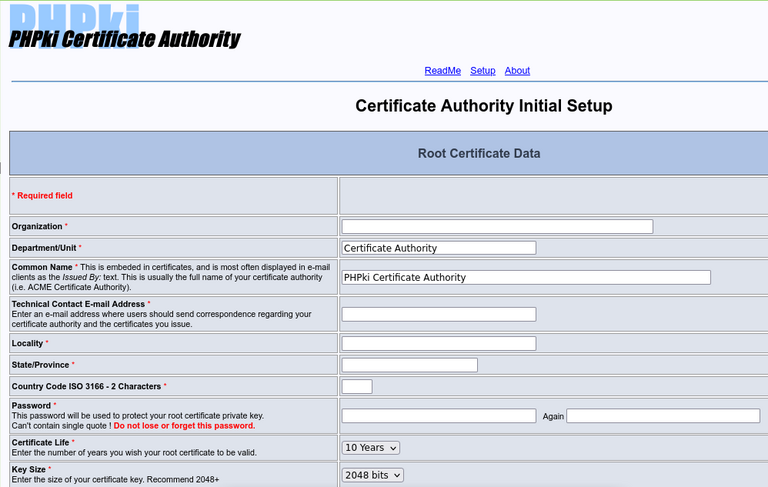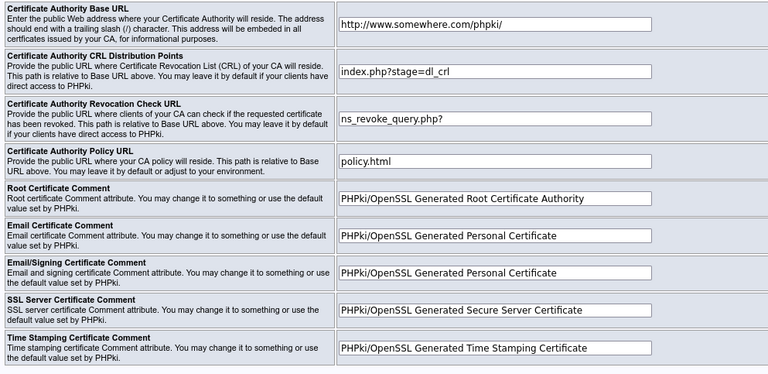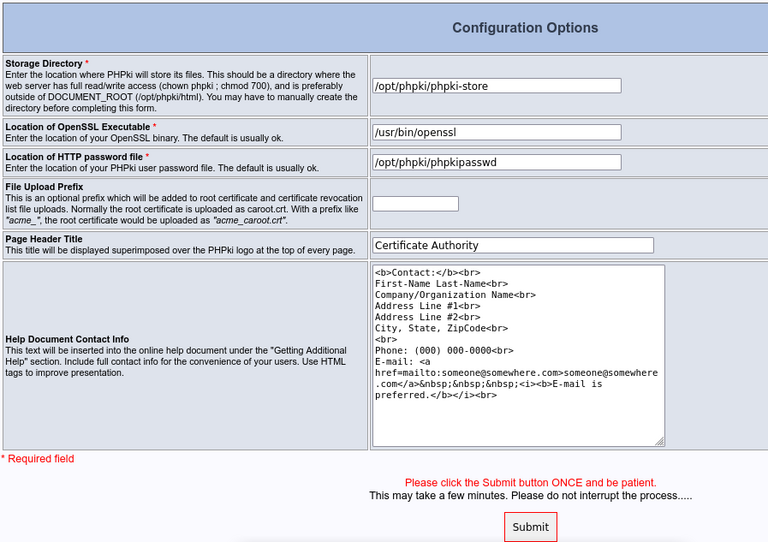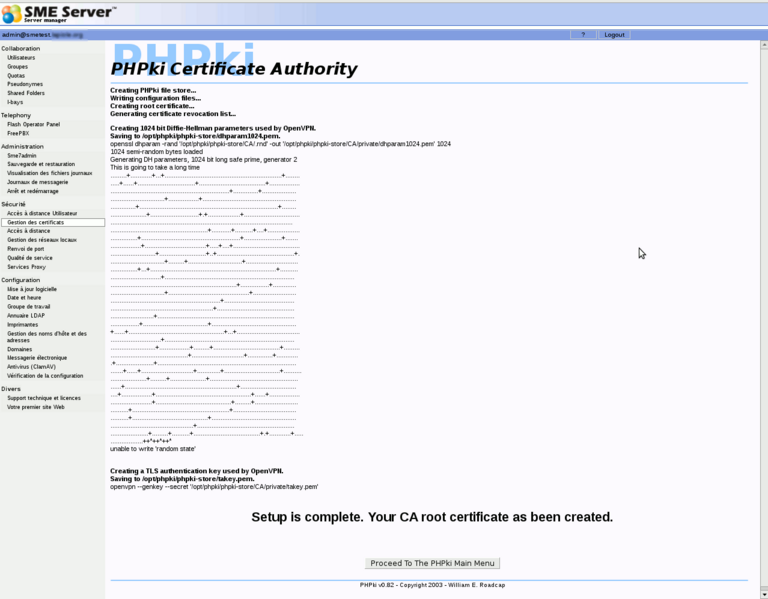Difference between revisions of "PHPki"
Unnilennium (talk | contribs) |
Unnilennium (talk | contribs) |
||
| Line 26: | Line 26: | ||
=== Requirements === | === Requirements === | ||
| − | |||
| − | |||
| − | |||
| − | |||
| − | |||
| − | |||
{{Warning box|This version of PHPki is a slightly modified version, so it can be used with certificates generated with previous release of smeserver-openvpn-bridge, plus some others minor modifications. | {{Warning box|This version of PHPki is a slightly modified version, so it can be used with certificates generated with previous release of smeserver-openvpn-bridge, plus some others minor modifications. | ||
| + | Starting phpki-ng-0.84, default_md has been upgraded to sha512 (previous was sha1). You can keep your existing CA working, but we strongly advise you to upgrade to a new instance, as the weak sha1 hash is a security issue. | ||
}} | }} | ||
| Line 144: | Line 139: | ||
yum remove smeserver-phpki-ng phpki-ng | yum remove smeserver-phpki-ng phpki-ng | ||
expand-template /etc/httpd/conf/httpd.conf | expand-template /etc/httpd/conf/httpd.conf | ||
| − | + | systemctl restart /service/httpd-e-smith | |
{{Note box|As with many other rpms, removing phpki won't remove everything from your server. Especially certificates will be kept, and some php files. PHPKi-ng will attempt to backup any old certificates. | {{Note box|As with many other rpms, removing phpki won't remove everything from your server. Especially certificates will be kept, and some php files. PHPKi-ng will attempt to backup any old certificates. | ||
| Line 157: | Line 152: | ||
=== Re-install === | === Re-install === | ||
| − | If you have removed the contrib, and want to re-install it, you'll need to follow these steps after you have installed the rpms: | + | |
| + | ==== before php-ki-ng 0.84-14 ==== | ||
| + | If you have removed the contrib, and want to re-install it keeping you previous CA (assuming you restored /opt/phpki), you'll need to follow these steps after you have installed the rpms: | ||
cd /opt/phpki/html/ | cd /opt/phpki/html/ | ||
| Line 182: | Line 179: | ||
{{#bugzilla:columns=id,product,version,status,summary |sort=id |order=desc |component=phpki-ng|noresultsmessage="No open bugs found."}} | {{#bugzilla:columns=id,product,version,status,summary |sort=id |order=desc |component=phpki-ng|noresultsmessage="No open bugs found."}} | ||
| + | === changelog === | ||
---- | ---- | ||
[[Category:Contrib]] | [[Category:Contrib]] | ||
[[Category:Administration:Certificates]] | [[Category:Administration:Certificates]] | ||
Revision as of 19:32, 14 December 2022
Maintainer
Previous: [1]Daniel B. from Firewall Services
Now maintained by Koozali SME
Version
Old version prior SME10:smeserver-phpki and phpki
New Version:
Please follow the installation instructions below. The installation instructions will satisfy all dependencies and the latest versions of the above 2 RPMs will be installed automatically.
Description
PHPki is an Open Source Web application for managing a multi-agency PKI for HIPAA compliance. With it, you may create and centrally manage X.509 certificates for use with S/MIME enabled e-mail clients, SSL servers, and VPN applications. PHPki is now used to manage certificates with the latest release of the SME Server OpenVPN Bridge contrib.
You can see a demo installation here
Requirements
Installation
- install the rpms
yum --enablerepo=smecontribs install smeserver-phpki-ng
go to the server-manager to the manage certificate menu and start creating your CA certificate
Warning click only once and wait for the page to update it can be very long to create the 4096 certificate...
you have to enable the epel repository
- install the rpms
yum --enablerepo=smecontribs,epel install smeserver-phpki
- and start/restart needed services:
expand-template /etc/httpd/conf/httpd.conf expand-template /etc/httpd/pki-conf/httpd.conf sv t /service/httpd-e-smith sv u /service/httpd-pki
- alternatively issue the following :
signal-event post-upgrade; signal-event reboot
on update you can issue
expand-template /etc/httpd/conf/httpd.conf expand-template /etc/httpd/pki-conf/httpd.conf sv t /service/httpd-e-smith sv t /service/httpd-pki
For sme8
- install the rpms
yum --enablerepo=smecontribs install smeserver-phpki
- and start/restart needed services:
expand-template /etc/httpd/conf/httpd.conf expand-template /etc/httpd/pki-conf/httpd.conf sv t /service/httpd-e-smith sv u /service/httpd-pki
- alternatively issue the following :
signal-event post-upgrade; signal-event reboot
Configure your new PKI
Go in the server-manager, you'll find a new "Manage Certificates" menu (or you can use the URL https://server.domain.tld/phpki/ca) Here you have to enter the following informations:
- Organisation
- Department
- Common Name of the Master CA
- E-mail (technical contact)
- City
- State
- Country Code
- Password (to protect the private key of the Master CA)
- Validity of the CA
- Keys size
- URL of your PKI (https://my.domain.tld/phpki)
These two screenshots illustrate the first (and the most important) part of this configuration page:
The second part is like this:
The default settings should be OK for most installations. You may just want to change the "Help Document Contact Info" part.
Once you have submitted this form (which can take several minutes, be patient, as generating dh parameters can take a long time), you should have something like this:
Now you'll be able to start using PHPki. It's quite easy to use.
The administrative interface is available on the server-manager or directly https://my.domain.tld/phpki/ca
There's also a public interface, available only from the local networks, but without password at https://my.domain.tld/phpki. Here, users can download the Master CA certificate, the CRL, or search for certificates of other users (public part only of course).
Add another admin
if you happen to need to delegate certifciate generation, you can use user-panel to add access to the panel, but you will also need to add the user manually to phpki config
edit /opt/phpki/phpki-store/config/config.php
#$PHPki_admins = Array(md5('admin'));
$PHPki_admins = Array(md5('admin'),md5('user2'));
Uninstall
To uninstall the contrib from your server, just run the following commands:
yum remove smeserver-phpki-ng phpki-ng expand-template /etc/httpd/conf/httpd.conf systemctl restart /service/httpd-e-smith
Certificates and PKI configuration are stored in /opt/phpki/phpki-store, php files are in /opt/phpki/html
Re-install
before php-ki-ng 0.84-14
If you have removed the contrib, and want to re-install it keeping you previous CA (assuming you restored /opt/phpki), you'll need to follow these steps after you have installed the rpms:
cd /opt/phpki/html/ rm -f index.php rm -f setup.php ln -s main.php index.php cat config.php.rpmsave > config.php cd ca rm -f index.php ln -s main.php index.php cd /opt/phpki/ chown phpki:phpki -R phpki-store chown root:phpki -R html/config.php
Bugs
Please raise bugs under the SME-Contribs section in bugzilla
For the new smeserver-phpki-ng select the smeserver-phpki-ng component or use this link
| ID | Product | Version | Status | Summary (4 tasks) ⇒ |
|---|---|---|---|---|
| 12436 | SME Contribs | 10.0 | CONFIRMED | failure to download crl |
| 12426 | SME Contribs | 10.0 | CONFIRMED | smeserver-phpki-ng Setting httpd-pki PHPVersion does not alter template |
| 12228 | SME Contribs | 10.0 | RESOLVED | wrong uid and gid |
| 10903 | SME Contribs | Futur | CONFIRMED | NFR: Save certificate bundle for ovpn configs |
Use this for bugs phpki-ng itself this link
| ID | Product | Version | Status | Summary (2 tasks) ⇒ |
|---|---|---|---|---|
| 12420 | SME Contribs | 10.0 | CONFIRMED | phpki-ng Create and download file has no name |
| 12275 | SME Contribs | 10.0 | CONFIRMED | PHP Warning: Use of undefined constant |



